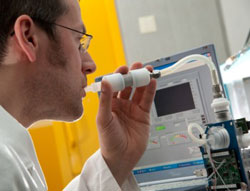Sensor Warns Patients in Advance of Asthma Attack

The sensor measures amounts as small as one ppb (part per billion), making it as sensitive as larger devices that are far more expensive and not portable. One ppb corresponds approximately to the dilution of a cube of sugar in a 50 meter-long swimming pool. The new sensor is contained in a prototype device that will be portable and only a little larger than a cell phone.
In patients suffering from asthma, the latent inflammation of the bronchial tubes generally spreads long before the patients actually feel anything. If the inflammation is intense, the air passages constrict and the patient has an asthma attack. The attacks can be so serious that the patient has to be treated in hospital, which is why many asthma sufferers regularly take anti-inflammatory medication. Previously, the only way to detect impending asthma attacks in advance was to conduct expensive pulmonary examinations to determine if the patient’s breath contained heightened levels of nitrogen monoxide (NO), which signal such an attack. By contrast, the new sensor from Siemens Corporate Technology will enable patients to analyze the NO in their breath themselves. As a result, they will be able to take the minimum amount of preventive medication and increase the dose only if really necessary.
The new sensor can detect increases in NO one day before an acute asthma attack occurs. Over the past few years, medical researchers and health insurance companies have recognized that NO levels are an effective indication of an impending asthma attack. In the analysis of a patient’s breath, the system first converts nitrogen monoxide into nitrogen dioxide, after which the air flows across the actual sensor. Only the particles signaling the attack adhere to the sensor’s surface. This generates a voltage that is measured by a field-effect transistor. The intensity of the voltage is directly dependent on the amount of nitrogen monoxide in the patient’s breath. On the basis of this value, the patient can decide what dose of anti-inflammatory medication he or she should take.
Another type of breath sensor under consideration would allow athletes to check whether they are exercising enough to burn fat. The detection principle is the same, except that the system measures the level of acetone. The latter is generated in the body when fat is burned and is also detectable in a person’s breath.
Media Contact
More Information:
http://www.siemens.com/innovationnewsAll latest news from the category: Information Technology
Here you can find a summary of innovations in the fields of information and data processing and up-to-date developments on IT equipment and hardware.
This area covers topics such as IT services, IT architectures, IT management and telecommunications.
Newest articles

Properties of new materials for microchips
… can now be measured well. Reseachers of Delft University of Technology demonstrated measuring performance properties of ultrathin silicon membranes. Making ever smaller and more powerful chips requires new ultrathin…

Floating solar’s potential
… to support sustainable development by addressing climate, water, and energy goals holistically. A new study published this week in Nature Energy raises the potential for floating solar photovoltaics (FPV)…

Skyrmions move at record speeds
… a step towards the computing of the future. An international research team led by scientists from the CNRS1 has discovered that the magnetic nanobubbles2 known as skyrmions can be…





















